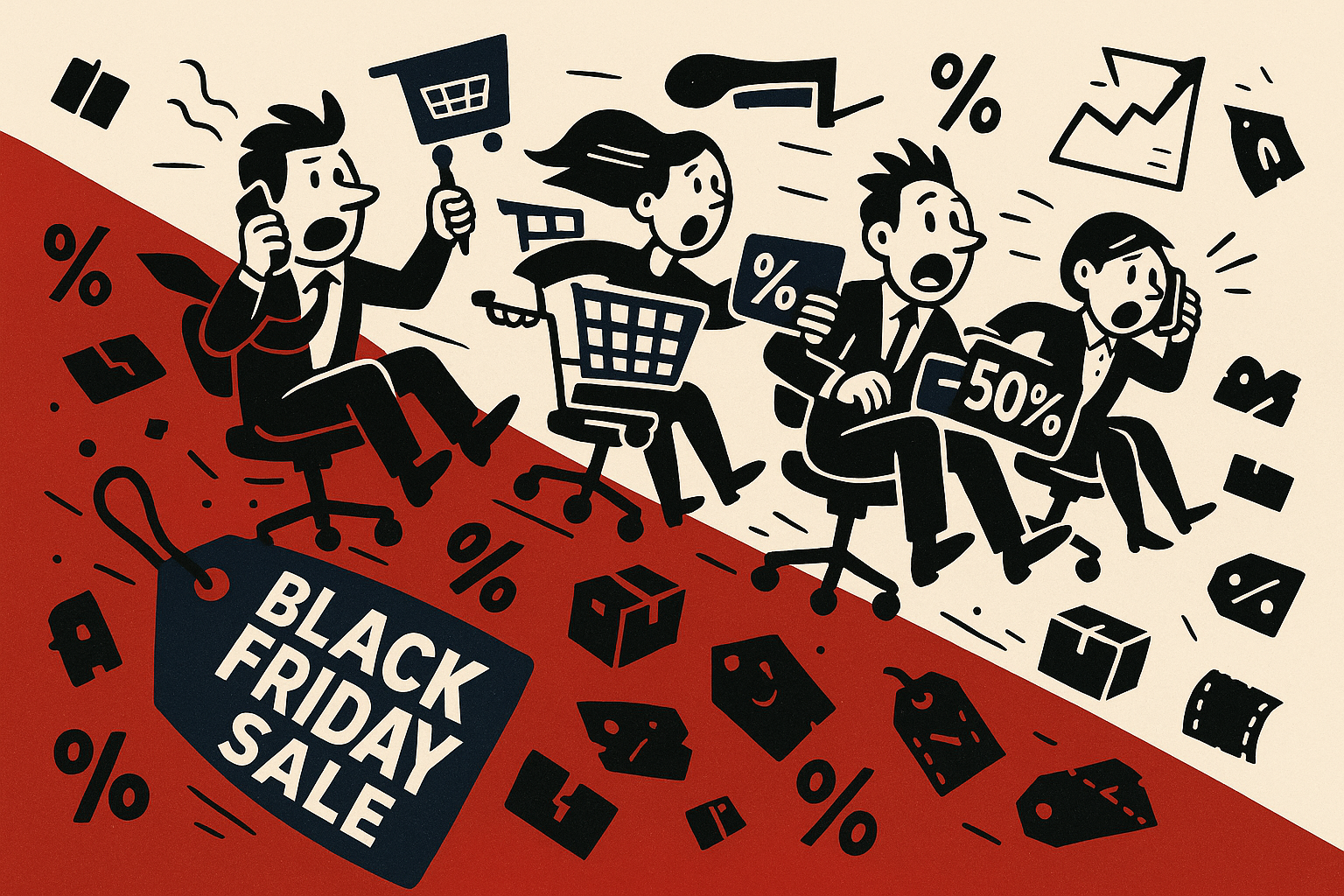Black Friday should be your most profitable sales period, not your longest.
Yet, each year Black Friday creeps earlier and earlier; where what was once a sales day has now turned into a whole month for some brands.
The increasingly early and drawn-out timeline of Black Friday has resulted in brands spending Q4 reacting to their competitors’ moves, rather than building out and executing their own unique, well-planned campaigns,
The result? Brands who simply try to stay competitive end up racing to the bottom; a pattern driven by reactive strategies and competitive pricing pressures.
Our take is simple… the consequences of acting reactively to try to “keep up” with the competition far outweigh the short-term sales spikes.
Our blog outlines exactly why, as well as some tips you can use to get out of reactive marketing mode and into acting strategically.
Blog in a Snapshot
If you read nothing else (although we hope you do stick around), here’s our blog in a snapshot:
- Don’t start your Black Friday sales early simply because your competitors do
- Reactive marketing only generate short term sales, but dilutes your brand, attracts the wrong type of customers, and erodes your long-term profitability
- Strategic marketing is planned and intentional – rather than reacting to competitors, we encourage you to plan your Q4 campaigns around your customers and goals
- Utilise other November smaller sales opportunities leading into Black Friday rather than cannibalising your biggest sale period of the year
Reactive Marketing
We see it time and time again; brands acting out of a place of reactivity rather than strategy, especially when it comes to big sales periods.
And trust us, we get it; your competitors are running their sale for the entire month of November, which propels the panic causing reactive marketing.
This panic is generally rooted in the fear of missing out on sales, fear that your customers will just go to the competitors who launched earlier, fear of not hitting Q4 targets, and the influence of shifting consumer behaviour.
This ultimately drives your team to pull the trigger on sales early, slash prices deeper, and push quick wins that undermine long-term performance.
In practice this looks like:
- “Our competitors just launched their Black Friday campaign in late October – we need to launch now too”
- “Sales are down, we need to double our ad spend this weekend”
- “The sale was supposed to end, but let’s extend it because our competitors did”
- Your competitor launched 35% off sitewide, so you immediately seek to match it with no consideration for margin, product mix, or customer value
The Cost of Being Reactive
Yes, in the short run, you may see some immediate sales as a result of being reactive, but the consequences far outweigh these short term benefits.
Reactive marketing results in:
- Eroding Your Margins: Competing on price will generate some immediate sales, but it will erode your margins and therefore profitability.
- Attracting the Wrong Type of Customers: These reactive tactics often focus on transaction volume rather than lifetime value, meaning you attract deal-chasers who unsubscribe or churn post-sale. Not to mention, your existing customers won’t be inclined to purchase anymore at full price.
- Brand Identity: Reactivity pushes you into competing on price rather than unique brand position, diluting your brand. By prioritising competing on price with your competitors, your differentiation is weakened, and in doing so, you’re alienating your customers who buy for quality rather than price.
- Loss of Trust: When your marketing is constantly shifting with frequent (reactive) pivots and contradictory messaging, your audience becomes desensitised to urgency and skeptical of your offers, ultimately pushing them away.
The Strategic Alternative
Strategic marketing is different; calmer, smarter, and built from a long-term lens, whereby you can utilise Q4 as a platform for growth.
The strategic approach includes:
- Planning in advance: Aligning creatives, offers, and budget around clear objectives
- Building anticipation: Warming up audiences through storytelling rather than discounting earlier
- Staying true to your position: Leading with value, not slashing prices
- Thinking beyond Q4: Treating every sale as the start of a customer relationship, not the end of one
The biggest difference between being reactive versus strategic is intent.
While reactive brands rush to start, strategic brands prepare in advance to finish strong.
Practical Shifts to Go From Reactive to Strategic
While reactive teams respond to noise, strategic teams plan for signals. Here are some tips to stay grounded when competitors turn up the volume:
1. Anchor to your objects, not competitors’ calendars
Before jumping to respond to your competitor’s early launch of black friday sales, ask yourself: Does this move help us hit our Q4 goal? If not, it’s simply noise which you shouldn’t act on.
Consider your overall objectives prior to jumping into reaction mode and build a filter in which every idea must ladder up to a measurable objective, such as increase average order value, grow email list, or reduce churn.
2. Run “pre-mortems”
Prior to launch, imagine the campaign fails, and ask yourself; what went wrong?
Was it that your audience wasn’t warmed up enough, or your messaging didn’t connect? Utilising this foresight makes you proactive rather than reactive when challenges appear.
3. Utilise rolling scenario plans
Rather than acting out of a panic, map out three pre-approved response paths to different scenarios: best case, steady state, and soft week. Doing so provides you with agility without the chaos when market conditions change.
4. Track leading indicators, not lagging ones
Rather than waiting for sales dips to react, motor metrics which may allow you to adjust before the panic sets in, such as email click-through rates, add-to-cart rates, ad engagement and CTR, and email list growth.
Other Opportunities to Consider Without Running a Month-Long Black Friday Sale
In Australia, there’s a multitude of promotional opportunities learning into black Friday that can build excitement without cannibalising your biggest sales period.
Too many brands treat November like one long discount marathon, but what we recommend instead is utilising the earlier events as momentum builders leading into Black Friday.
Sales opportunities such as Single’s Day (11/11) and Click Frenzy (11/11 – 14/11) are great opportunities to run smaller sales in the lead up to Black Friday, without needing to bring Black Friday sales earlier into the month.
However, if you choose to utilise these opportunities, it’s essential that you still treat Black Friday as the main event with the biggest discounts, as this is what’s expected from your customers. Your brand can also strategically prepare for Boxing Day sales to sustain post-Black Friday engagement.
Final Thoughts
If you’ve taken anything away, we hope you can see that Q4 shouldn’t be a race to start first, it should be a race to finish stronger.
When brands give in to the panic of keeping up with their competitors, they trade strategy for speed and volume. Which, yes, may result in short-term spikes, but these come at a cost to your margins, brand identity and customer trust.
Strategic marketing isn’t about doing what your competitors are doing, it’s about knowing your customers, your brand goals and values, and acting in alignment with this.
If you want to achieve your most profitable Q4 yet, don’t do what everyone else is just to “keep up”.
Our step-by-step playbook guides you through running high-converting seasonal promotions and how to turn this sales season into long-term growth!
Download our free guide: The Golden Recipe for Black Friday Cyber Monday Promotions and get actionable strategies you can use right now to win BFCM.









